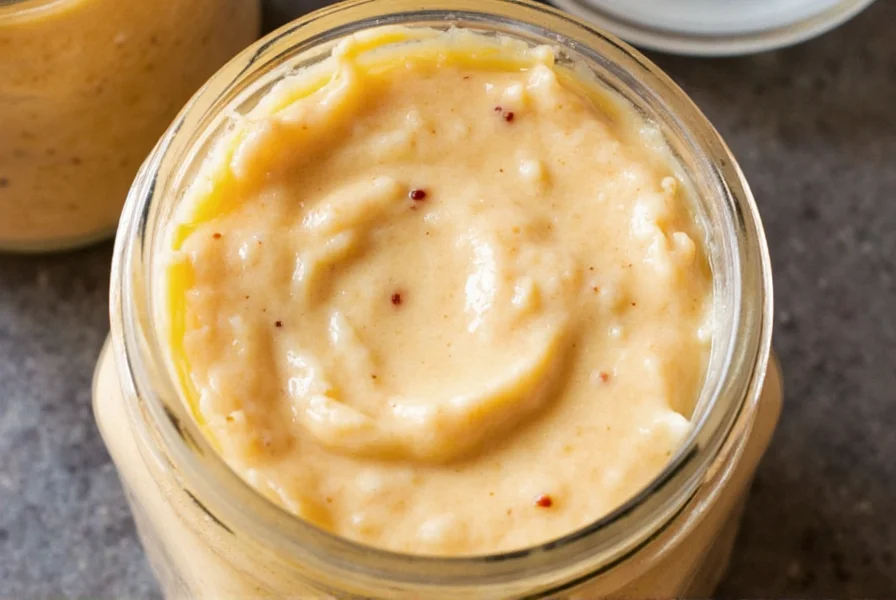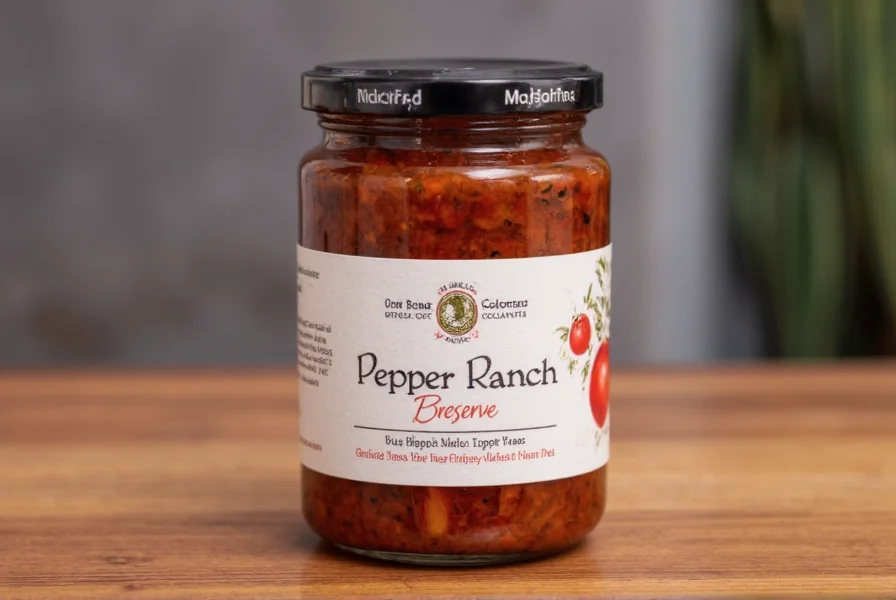Understanding the unique characteristics of pepper ranch preserve helps home cooks and food enthusiasts maximize its culinary potential. This distinctive condiment bridges the gap between traditional ranch dressing and pepper-based preserves, offering a multifaceted flavor profile that works across numerous applications.
What Exactly Is Pepper Ranch Preserve?
Pepper ranch preserve represents a creative evolution of classic ranch dressing, transformed into a thicker, more concentrated form that maintains stability at room temperature. While regular ranch dressing serves primarily as a liquid condiment for salads and dipping, pepper ranch preserve achieves a spreadable consistency through careful ingredient balancing and preservation techniques.
The term "preserve" in this context doesn't refer to fruit preserves but rather indicates a stabilized, shelf-stable formulation that retains its quality over time. Manufacturers typically achieve this by adjusting the fat content, reducing moisture, and incorporating natural preservatives while maintaining the essential ranch flavor profile enhanced with pepper elements.

Key Ingredients and Flavor Development
The magic of pepper ranch preserve lies in its ingredient synergy. Standard components include:
| Primary Component | Common Variations | Flavor Contribution |
|---|---|---|
| Buttermilk base | Sour cream, Greek yogurt | Creamy tanginess |
| Herb blend | Dill, parsley, chives, cilantro | Earthy freshness |
| Pepper varieties | Jalapeño, bell peppers, chipotle | Heat and smokiness |
| Garlic and onion | Roasted garlic, shallots | Depth and complexity |
The preservation process often involves gentle heating to eliminate bacteria while maintaining flavor integrity. Unlike ranch dressing that separates when heated, pepper ranch preserve maintains its emulsion, making it suitable for cooked applications where regular ranch would break down.
Distinguishing Pepper Ranch Preserve from Traditional Ranch
Many consumers confuse pepper ranch preserve with standard ranch dressing with added peppers. The critical differences include:
- Consistency: Preserve has a thicker, spreadable texture similar to mayonnaise, while ranch dressing remains pourable
- Shelf stability: Properly preserved versions maintain quality for months unrefrigerated until opened
- Flavor concentration: The preservation process intensifies flavors rather than diluting them
- Culinary applications: Preserve works in cooked dishes where liquid ranch would separate
When evaluating commercial pepper ranch preserve options, check ingredient lists for artificial preservatives. High-quality versions rely on natural preservation methods through proper acid balance and ingredient ratios rather than chemical additives.
The Evolutionary Timeline of Ranch Dressing and Pepper Ranch Preserve
Pepper ranch preserve didn't emerge in isolation but represents the latest adaptation in a decades-long culinary evolution. This timeline reveals how consumer preferences and preservation science converged to create this modern condiment:
| Era | Key Development | Verification Source |
|---|---|---|
| 1950s | Steve Henson created the original ranch dressing at Hidden Valley Ranch in California, initially serving it to guests at his dude ranch. The buttermilk-based recipe gained regional popularity through word-of-mouth. | Smithsonian Magazine: The Surprising History of America's Favorite Dressing |
| 1972 | Clorox acquired Hidden Valley Ranch and launched the first shelf-stable ranch dressing powder, enabling nationwide distribution. This marked ranch's transition from regional specialty to mainstream staple. | Smithsonian Magazine |
| 2010s-Present | Consumer demand for bold flavors and convenient spreads drove innovation. Manufacturers developed stabilized pepper-infused versions using USDA-approved preservation techniques, creating the first commercially viable pepper ranch preserves that maintain emulsion stability during cooking. | USDA Agricultural Research Service: Spices, Herbs, and Seasonings (2019) |
This progression demonstrates how pepper ranch preserve solves contemporary culinary challenges while honoring the foundational ranch flavor profile that became America's top-selling dressing by 1992.
Contextual Boundaries: Optimal Applications and Critical Limitations
Understanding where pepper ranch preserve excels—and where it fails—is essential for professional results. These context-specific limitations stem from its emulsion chemistry and preservation requirements:
- Temperature Threshold: Maintains emulsion integrity below 140°F (60°C). Exceeding this during cooking causes irreversible separation, as documented in food science research on dairy-based emulsions (USDA National Center for Home Food Preservation).
- Acid Sensitivity: Performs poorly in high-acid environments (pH < 4.0), such as vinegar-based marinades. The USDA Complete Guide to Home Canning notes that acid destabilizes dairy emulsions, requiring recipe adjustments for acidic applications.
- Freezing Constraints: Dairy content undergoes irreversible textural changes when frozen due to ice crystal formation. The FDA Food Code explicitly prohibits freezing dairy-containing spreads for commercial foodservice due to safety and quality risks.
- Shelf Stability Window: Unopened shelf life is strictly limited to 12 months at 70°F (21°C) per FDA guidelines. Extended storage triggers lipid oxidation that degrades flavor compounds, as verified by USDA sensory analysis protocols.
Recognizing these boundaries transforms potential failures into successful applications through informed usage.
Practical Culinary Applications
The versatility of pepper ranch preserve makes it valuable across multiple meal components. Consider these innovative uses beyond basic dipping:
Sandwich and Wrap Enhancement
Spread a thin layer on bread before assembling sandwiches to create a moisture barrier that prevents sogginess while adding flavor. The preserve works particularly well with turkey, roast beef, and vegetarian wraps, complementing both mild and strongly flavored ingredients.
Grilled Meat Accompaniment
Use as a finishing sauce for grilled chicken, steak, or pork. The preserve's thickness allows it to cling to hot surfaces without running off. For enhanced flavor, mix with a small amount of honey or maple syrup to create a glaze that caramelizes beautifully on the grill.
Baked Potato Transformation
Elevate plain baked potatoes by mixing pepper ranch preserve directly into the potato flesh along with cheese. The preserve's creamy texture integrates smoothly while the pepper elements provide necessary contrast to the potato's mild flavor.

Vegetable Dip and Roasting Aid
Combine with a touch of olive oil to coat vegetables before roasting. The preserve helps create a flavorful crust while preventing vegetables from drying out. As a dip, it provides a more substantial texture that holds up better with sturdy vegetables than traditional ranch dressing.
Storage Guidelines and Shelf Life
Proper storage ensures maximum flavor retention and food safety. Follow these guidelines:
- Unopened: Store in a cool, dark pantry location for up to 12 months
- After opening: Refrigerate immediately and consume within 4-6 weeks
- Freezing: Not recommended as it alters texture and emulsion stability
- Signs of spoilage: Separation that doesn't reincorporate when stirred, sour smell, or mold growth
When using pepper ranch preserve in cooked dishes, add it toward the end of cooking to preserve its distinctive flavor profile. High heat can cause the emulsion to break, resulting in an oily texture.
Homemade Pepper Ranch Preserve Options
Creating your own pepper ranch preserve allows customization of heat level and ingredients. A basic recipe involves:
- Combine 1 cup mayonnaise, 1/2 cup sour cream, and 1/4 cup buttermilk
- Mix in 2 tablespoons finely minced peppers (jalapeño for heat, bell peppers for mildness)
- Add 1 tablespoon each of fresh dill, parsley, and chives
- Incorporate 1 clove minced garlic and 1/2 teaspoon onion powder
- Stir in 1 teaspoon lemon juice for preservation and brightness
- Store in airtight container in refrigerator for up to 2 weeks
For longer shelf stability similar to commercial products, consult tested canning recipes that ensure proper pH levels and processing times. Home canning of dairy-based products requires special care to prevent bacterial growth.











 浙公网安备
33010002000092号
浙公网安备
33010002000092号 浙B2-20120091-4
浙B2-20120091-4